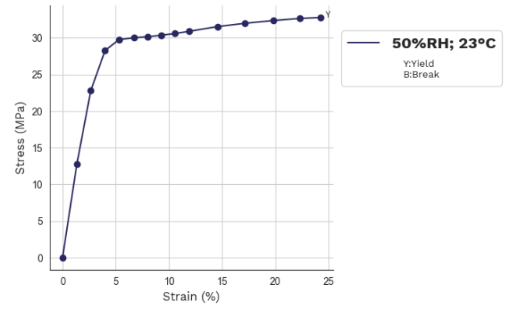Enhanced TDS
Identification & Functionality
- Additives Included
- Blend
- Yes
- Chemical Family
- Polymer Name
- Product Code
- MITM16536
- Single Ingredient
- No
- Technologies
- Product Families
Features & Benefits
- Labeling Claims
- Materials Features
Applications & Uses
- Plastics & Elastomers End Uses
- Plastics & Elastomers Processing Methods
- Technical Data
Stress-Strain - PEBAX® Rnew® 80R53 SP 02

- Processing Information
- Typical melt temperature (Min / Recommended / Max) - Injection Molding: 230°C / 260°C / 290°C (445°F / 500°F / 555°F)
- Typical mold temperature - Injection molding: 20 - 60°C (70 - 140°F)
- Drying time and temperature: 70 - 80°C (160 - 175°F) / 4 - 6 hours
Properties
Principal Information
- Group Principal Number
- S000003
- Principal
Storage & Handling
- Storage Information
Two years from the date of delivery, when stored properly (sealed bags, appropriate moisture, UV protection and temperature).
Other
- Color (SDS)
- Translucent
- Insoluble in (SDS)
- Water
- Item Number
- Odor (SDS)
- Odorless
- Other Hazards
- The product, in the form supplied, is not anticipated to produce significant adverse human health effects. Contains high molecularweight polymer(s). Effects due to processing releases: Irritating to eyes, respiratory system and skin.Prolonged or repeated exposure may cause: headache, drowsiness, nausea, weakness, (severity of effects depends on extent ofexposure), Processing may release vapors and/or fumes which cause eye, skin and respiratory tract irritation.
- Temperature Control
- Yes
- USA/DOT UN Number
- Not Applicable
- Material Composition
Value Units Test Method / Conditions Renewable Carbon Content 92.0 % % ASTM D6866 - Mechanical Properties
Value Units Test Method / Conditions Flexural Modulus 840.0 MPa MPa ISO 178 at 23°C, conditioned Flexural Modulus 944.0 MPa MPa ISO 527-2 at 23°C, 1 mm/min, conditioned Hardness 67.0 Shore D Shore D ISO 868 at 15s, conditioned Nominal Strain at Break min. 300.0 % % ISO 527-2 at 23°C, 50 mm/min, conditioned Strain at Yield 24.0 % % ISO 527-2 at 23°C, 50 mm/min, conditioned Stress at Break 52.0 MPa MPa ISO 527-2 at 23°C, 50 mm/min, conditioned Stress at Yield 33.0 MPa MPa ISO 527-2 at 23°C, 50 mm/min, conditioned - Physical Properties
Value Units Test Method / Conditions Melting Point 188.0 °C °C ISO 11357-1 at 10°C/min Shrinkage 1.3 % % ISO 294-4 Normal (t+24h) Shrinkage 1.2 % % ISO 294-4 Parallel (t+24h) Specific Gravity 1.02 - ISO 1183-1 at 23°C Storage Temperature max. 140.0 °F °F Water Absorption 0.8 % % ISO 62 at 23°C, 50%HR, equilibrium Water Absorption 0.7 % % ISO 62 at 23°C, immersion, equilibrium - SDS Physical and Chemical Properties
Value Units Test Method / Conditions Autoignition Temperature (SDS) 698.0-842.0 °F °F ASTM D1929 Bulk Density (SDS) 550.0-650.0 kg/m³ kg/m³ Decomposition Temperature (SDS) 572.0-662.0 °F °F Density (SDS) 1.02-1.03 g/cm³ g/cm³ Melting Point (SDS) 284.0-374.0 °F °F Specific Gravity (SDS) 1.02-1.03 - at 20°C, Water = 1 Specific Gravity (SDS) 1.02-1.03 - at 20°C, Water=1 - Shelf Life & Stability
Value Units Test Method / Conditions Shelf Life 2.0 yr yr
